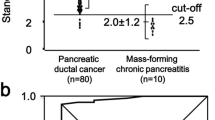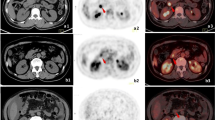Abstract
The purpose of this study was to investigate the feasibility of [18F]2-deoxy-2-fluoro-d-glucose (FDG) positron emission tomography (PET) in patients with a pancreatic mass by comparing the results with those of X-ray computed tomography (CT) and magnetic resonance (MR) imaging.Methods: Eighty-six patients with pancreatic lesions, included 65 malignant tumors and 21 benign masses (55 masses were proven histologically and the others were diagnosed clinically), were studied. The diagnostic factors of CT and MR imaging were evaluated, and those of FDG PET were also evaluated for malignant and benign masses by visual interpretation and quantitative interpretation with the standardized uptake value (SUV) and SUV gluc which was designed to reduce the effects of a high blood sugar level. Visual interpretations were evaluated only in FDG PET images, and quantitative interpretations were evaluated by referring to CT and/or MR imaging. The correlation between SUV and the degree of histological differentiation in pancreatic ductal adenocarcinoma was investigated.Results: Sensitivity, specificity, positive predictive value (PPV), negative predictive value (NPV) and accuracy for CT imaging were 91, 62, 88, 68 and 84%, and for MR imaging 78, 70, 88, 54 and 76%, respectively. In visual interpretation of FDG PET images, the sensitivity, specificity, PPV, NPV and accuracy were 82, 81, 93, 59 and 81%, respectively. Significant differences between malignant and benign lesions existed in SUV and SUV gluc (p<0.0001, each). With the cutoff value of SUV as 2.1 and SUV gluc as 2.2, the accuracy of diagnosis was maximal. With that cutoff value, the sensitivity, specificity, PPV, NPV and accuracy for SUV were 89, 76, 92, 70 and 86%, and for SUV gluc 91, 76, 92, 73 and 87%, respectively. The sensitivity and NPV of SUV gluc were higher than those of SUV, which suggests that SUV gluc may be more useful in reducing the number of overlooked malignant tumors. The specificity and PPV of FDG PET were superior to those of CT and MR imaging. There were no significant differences between the SUVs of moderately differentiated adenocarcinomas and those of well differentiated adenocarcinomas.Conclusion: To improve the diagnostic procedure for classifying masses, FDG PET with not only SUV but also SUV corrected by the blood sugar level is required in addition to morphological diagnosis by CT and/or MR imaging.
Similar content being viewed by others
References
Tamakoshi A, Lin Y, Ohno Y. Mortality and incidence of pancreatic cancer.Sogorinsho 1999; 48: 1640–1648. (in Japanese)
Bida GT, Satyamurthy N, Barrio JR. The synthesis of 2-[F-18] fluoro-2-deoxy-d-glucose using glycals: a reexamination.J Nucl Med 1984; 25: 1327–1334.
Di Chiro G. Positron emission tomography using [18F] fluorodeoxyglucose in brain tumors: a powerful diagnostic and prognostic tool.Invest Radiol 1986; 22: 360–371.
Strauss LG, Conti PS. The applications of PET in clinical oncology.J Nucl Med 1991; 32: 623–648; discussion 649–650.
Zimny M, Bares R, Fass J, Adam G, Cremerius U, Dohmen B, et al. Fluorine-18 fluorodeoxyglucose positron emission tomography in the differential diagnosis of pancreatic carcinoma: a report of 106 cases.Eur J Nucl Med 1997; 24: 678–682.
Diederichs CG, Staib L, Glatting G, Beger HG, Reske SN. FDG PET: elevated plasma glucose reduces both uptake and detection rate of pancreatic malignancies.J Nucl Med 1998; 39: 1030–1033.
Freeny PC, Traverso LW, Ryan JA. Diagnosis and staging of pancreatic adenocarcinoma with dynamic computed tomography.Am J Surg 1993; 165: 600–606.
Semelka RC, Ascher SM. MR imaging of the pancreas.Radiology 1993; 188: 593–602.
Kato T, Fukatsu H, Ito K, Tadokoro M, Ota T, Ikeda M, et al. Fluorodeoxyglucose positron emission tomography in pancreatic cancer: an unsolved problem.Eur J Nucl Med 1995; 22: 32–39.
Procacci C, Biasiutti C, Carbognin G, Accordini S, Bicego E, Guarise A, et al. Characterization of cystic tumors of the pancreas: CT accuracy.J Comput Assist Tomogr 1999; 23: 906–912.
Müller MF, Meyenberger C, Bertschinger P, Schaer R, Marincek B. Pancreatic tumors: evaluation with endoscopic US, CT, and MR imaging.Radiology 1994; 190: 745–751.
Vellet AD, Romano W, Bach DB, Passi RB, Taves DH, Munk PL. Adenocarcinoma of the pancreatic ducts: comparative evaluation with CT and MR imaging at 1.5 T.Radiology 1992; 183: 87–95.
Klever P, Bares R, Fass J, Büll U, Schumpelick V. PET with fluorine-18 deoxyglucose for pancreatic disease [letter].Lancet 1992; 340: 1158–1159.
Inokuma T, Tamaki N, Torizuka T, Fujita T, Magata Y, Yonekura Y, et al. Value of fluorine-18-fluorodeoxyglucose and thallium-201 in the detection of pancreatic cancer.J Nucl Med 1995; 36: 229–235.
Syrota A, Comar D, Cerf M, Plummer D, Mazière M, Kellershohn C. [11C]methionine pancreatic scanning with positron emission computed tomography.J Nucl Med 1979; 20: 778–781.
Kirchner PT, Ryan J, Zalutsky M, Harper PV. Positron emission tomography for the evaluation of pancreatic disease.Semin Nucl Med 1980; 10: 374–391.
Stollfuss JC, Glatting G, Friess H, Kocher F, Beger HG, Reske SN. 2-(fluorine-18)-fluoro-2-deoxy-d-glucose PET in detection of pancreatic cancer: value of quantitative image interpretation.Radiology 1995; 195: 339–344.
Bares R, Klever P, Hauptmann S, Hellwig D, Fass J, Cremerius U, et al. F-18 fluorodeoxyglucose PETin vivo evaluation of pancreatic glucose metabolism for detection of pancreatic cancer.Radiology 1994; 192: 79–86.
Friess H, Langhans J, Ebert M, Beger HG, Stollfuss J, Reske SN, et al. Diagnosis of pancreatic cancer by 2[18F]-fluoro-2-deoxy-d-glucose positron emission tomography.Gut 1995; 36: 771–777.
Langen KJ, Braun U, Rota Kops E, Herzog H, Kuwert T, Nebeling B, et al. The influence of plasma glucose levels on fluorine-18-fluorodeoxyglucose uptake in bronchial carcinomas.J Nucl Med 1993; 34: 355–359.
Ho CL, Dehdashti F, Griffeth LK, Buse PE, Balfe DM, Siegel BA. FDG-PET evaluation of indeterminate pancreatic masses.J Comput Assist Tomogr 1996; 20: 363–369.
Cremerius U, Fabry U, Neuerburg J, Zimny M, Osieka R, Buell U. Positron emission tomography with18F-FDG to detect residual disease after therapy for malignant lymphoma.Nucl Med Commun 1998; 19: 1055–1063.
Reisser C, Haberkorn U, Strauss LG. The relevance of positron emission tomography for the diagnosis and treatment of head and neck tumors.J Otolaryngol 1993; 22: 231–238.
Imdahl A, Nitzsche E, Krautmann F, Hogerle S, Boos S, Einert A, et al. Evaluation of positron emission tomography with 2-[18F]fluoro-2-deoxy-d-glucose for the differentiation of chronic pancreatitis and pancreatic cancer.Br J Surg 1999; 86: 194–199.
Higashi T, Tamaki N, Torizuka T, Nakamoto Y, Sakahara H, Kimura T, et al. FDG uptake, GLUT-1 glucose transporter and cellularity in human pancreatic tumors.J Nucl Med 1998; 39: 1727–1735.
Author information
Authors and Affiliations
Corresponding author
Rights and permissions
About this article
Cite this article
Koyama, K., Okamura, T., Kawabe, J. et al. Diagnostic usefulness of FDG PET for pancreatic mass lesions. Ann Nucl Med 15, 217–224 (2001). https://doi.org/10.1007/BF02987835
Received:
Accepted:
Issue Date:
DOI: https://doi.org/10.1007/BF02987835




